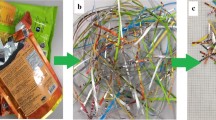Abstract
Fiber-reinforced plastic (FRP) is one of the gifts to technology that has influenced human life in numerous ways. FRP represents plastic which contains fibers of other materials that add strength, flexibility, durability, and other virtues to the plastic. From the past years, FRP being some composite materials has been used in many industries. But disposal of this FRP waste is becoming a major problem because of increased generation in FRP materials from various industries mainly from windmills. The study deals with use of FRP waste as an additive in concrete, thereby checking the effect of FRP waste on concrete characteristics. Concrete cubes, cylinders, and prisms of M-25 grade concrete were casted with different percentage of FRP waste (0, 1, 2, 3, and 4%) as an additive by the weight of the cement. From the results of compressive strength, flexural strength, and split tensile strength, of the concrete with and without FRP waste, it is observed that the compressive strength, flexural strength, and split tensile strength of the concrete specimens increase when 3% of FRP waste is used as an additive. Hence, 3% of FRP waste can be considered as optimum dosage to be used in concrete.
Access this chapter
Tax calculation will be finalised at checkout
Purchases are for personal use only
Similar content being viewed by others
References
Siddigue R, Kaur I, Kahtib J (2008) Use of recycled plastic in concrete: a review, vol 28, pp 835–185. Elsevier
Ministry of Environment, Forests and Climate Chang GOI (2016) Guidelines for disposal of thermoset plastic waste including sheet moulding compound (SMC)/fiber reinforced plastic (FRP), Working Papers id:10822, eSocialSciences
Ramesh N, Abbasi T, Tauseef SM, Abbasi SA (2018) Utilization of fiber-reinforced plastic (FRP) waste generated by a wind-turbine manufacturing company. Int J Eng Sci Res 6
Ribeiro MC, Fiúza A, Ferreira A, Dinis MD, Meira Castro AC, Meixedo JP, Alvim MR (2016) Recycling approach towards sustainability advance of composite materials industry. J Sci Res 178–193
Rai B, Rushad ST, Bhavesh K, Duggal SK (2012) Study of waste plastic mix concrete and plasticizer. Int Sch Res Not Civil Eng 2012:5
Author information
Authors and Affiliations
Corresponding author
Editor information
Editors and Affiliations
Rights and permissions
Copyright information
© 2021 Springer Nature Switzerland AG
About this paper
Cite this paper
Rekha, H.B., Kiran, T., Jayaramappa, N., Tuppad, P. (2021). Sustainable Solution for the Disposal of Fiber-Reinforced Plastic Waste. In: Reddy, K.R., Agnihotri, A.K., Yukselen-Aksoy, Y., Dubey, B.K., Bansal, A. (eds) Sustainable Environment and Infrastructure. Lecture Notes in Civil Engineering, vol 90. Springer, Cham. https://doi.org/10.1007/978-3-030-51354-2_9
Download citation
DOI: https://doi.org/10.1007/978-3-030-51354-2_9
Published:
Publisher Name: Springer, Cham
Print ISBN: 978-3-030-51353-5
Online ISBN: 978-3-030-51354-2
eBook Packages: EngineeringEngineering (R0)




